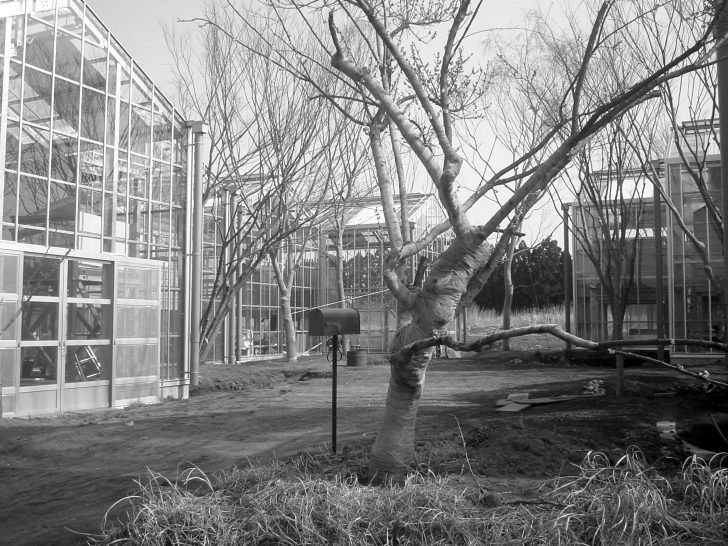Life in a greenhouse offers an ecological escape from the city.
Driving east along the highway, the concrete landscape and high-rise buildings of Tokyo gradually give way to green fields and trees. About two hours outside of the city center, a highway exit leads us into the Japanese countryside, full of bamboo forests, rice paddies and farmhouses. This timeless traditional scene unfolding before us is the setting for a brand-new utopian experiment called Millennium City.
On a plot of open farmland in Chiba, four giant paneled-glass structures resembling greenhouses have been erected. Instead of housing vegetables or tropical flora, the glass houses contain small wooden pavilions, each consisting of an enclosed upper level and an open platform below. The enclosed space is an elevated room on stilts, not unlike a tree house, with a ladder leading up to the entrance. Underneath, the open platform, reminiscent of the traditional Indonesian open-sided thatched huts known as berugas, appears to float just above the earthen floor. Though the two spaces have no designated function, it seems that the elevated hut would serve nicely as a sleeping space while the open platform below could be used for just about anything – reading, relaxing, a make-shift garden or studio space, or entertaining. Though small and exceedingly minimal, these wooden pavilions inside their glass carapaces were in fact designed as retreat living spaces; one of the glass houses contains a communal kitchen and a separate pavilion has shared toilet and bathing facilities.

This extraordinary glass complex is an ecological community founded by an ambitious architect called Hiroshi Iguchi. Looking for alternatives to Japan’s modern housing situation, Iguchi came up with the concept of Millennium City. Developed as a kind of environment-friendly commune, Millennium City allows people to live close together, yet in privacy, and enables them to enjoy a lifestyle in harmony with nature. The concept of the glass village is a product of several workshops Iguchi organized with volunteers and students. They experimented with minimal living spaces and the required proportions of private versus shared space, and developed models for saving energy. The glass encasements serve as greenhouses, effectively drawing on solar energy for lighting and heating their internal bungalows.
Iguchi is eager to elaborate further. “For heating, we use passive and active solar energy,” he explains. “The sun heats up the inside air in winter, when there are no leaves on the trees. In summer the trees provide natural shade, shielding the houses from most of the sun’s heat. We also have a few solar panels that can heat water up to 50 degrees.”
In the realization phase of the plan, the network of members proved extremely efficient. First, Iguchi established a non-profit organization to attract like-minded people, one of whom happened to be the president of the Japanese Agricultural Association, who offered them a 20-year lease on a generous piece of land in Chiba. Through the personal connections of other members, many materials were donated or supplied at a lower cost. The trees were a gift, as well as the kitchen furniture, bathroom fixtures and many other amenities. Though the glass houses were built by an actual greenhouse-manufacturer, volunteers built the wooden pavilions, significantly reducing the total cost of the project – the entire complex was thus completed within a budget of about \4.5 million.
 The commune is structured on the assumption that the pavilions will be rented out for temporary accommodation, although some of them could also be permanently occupied. With rent at about \5,000 per month, the pavilions make for an affordable seasonal get-away or extremely reasonable year-round rent in the inflated Japanese real-estate market. But much more than a living community, the glass village will also function as an art school, where tea ceremony, flower arrangement and painting courses can be held. In addition, the organization of classes on ecological agriculture and exchanges with agriculture students is planned.
The commune is structured on the assumption that the pavilions will be rented out for temporary accommodation, although some of them could also be permanently occupied. With rent at about \5,000 per month, the pavilions make for an affordable seasonal get-away or extremely reasonable year-round rent in the inflated Japanese real-estate market. But much more than a living community, the glass village will also function as an art school, where tea ceremony, flower arrangement and painting courses can be held. In addition, the organization of classes on ecological agriculture and exchanges with agriculture students is planned.
And as for the other environmentally-friendly benefits of the glass village? “The fact that this one place facilitates so many different functions is, in itself, already ecological,” Iguchi explains. “The huts can always be recycled or reused either by dismantling and re-assembling them in a new location, or just by moving them in tact.”
Iguchi notes that he has tried to avoid using high-tech instruments in order to save energy. In fact, Iguchi says he found it much cheaper to heat the pavilions the old-fashioned way – namely, reduce the space that requires heating to a minimum and adapt one’s daily routine to the outside light and temperature. “In the end it will be its own biotope,” he says.
On an early summer morning, the sun has already evaporated the mist on the glass and warmed the interior of the glass house to a pleasant temperature. The red sand of the floor is scattered about everywhere, a sign that the anticipated biotope is not yet working perfectly. “We will need to grow grass and plants in the earth,” he says.
I try to imagine living in one of the tiny huts inside the glass houses… it must be somewhere between camping and living in a holiday lodge. I wonder why people wanting to be close to nature wouldn’t prefer to find a simple old farmhouse in the middle of nowhere, forgetting that the point here is to live amongst others, in a community. But unlike the communes in Europe in the seventies, I doubt that even a hard-core hippie could have put up with so little privacy. In the end, however, I remember that this is Japan, where people are used to living in semi-detached houses butting up against their neighbours’ bedroom windows, to travelling in packed trains and dining in cramped cafeterias. Is this really an escape from that reality?
According to Iguchi, it doesn’t have to be. “I can imagine a normal family with children moving into Millennium City. The father can commute to Tokyo for work and have something peaceful to look forward to when he comes home in the evening.”
The name hints at the ambition to be an alternative approach to building in this new millennium. Iguchi has big plans for the future of Millennium City. Now it consists only of four glass houses, but it could turn into an entire “city” if the formula proves successful. A developer has picked up his ideas and tabled plans to make a similar village on the seaside. Iguchi is also altering his own little office environment, located at the top of a tall building in Tokyo, toward something more natural, ecological.
“I am growing giant plants and trees inside, so I can work in a jungle,” he says.
In the impervious concrete jungle that is Tokyo, Iguchi’s dream of living and working in nature may have to wait until the next millennium, but for now, Millennium City is a sample of what concept, ambition and team-work can do for the environment in a remote little corner of our planet.
Text and photos by Femke Bijlsma
From J SELECT Magazine, September 2004















Recent Comments